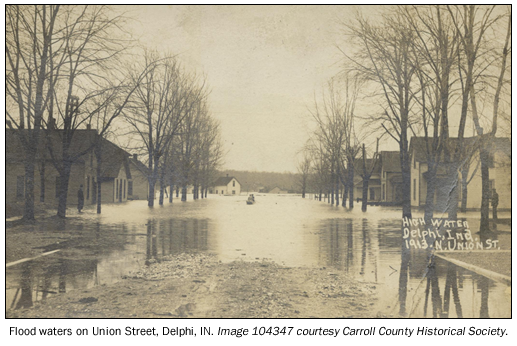The Great Flood of 1913
100 Years Later
Community Profiles: Delphi, Indiana
| River: | Wabash |
| Storm Total Rainfall: | |
| Known Fatalities: |
Timeline
Spring of 1913 was a tumultuous one for Delphi, Indiana. Situated near the confluence of the Wabash River and Deer Creek, and featuring meeting points for road, rail, and canal traffic, the town is located in a geographical "bowl". When it fills up, homes are flooded, roads are shut, and bridges collapse.
Early on March 23rd rain began to fall, and it didn't stop until it turned to snow. At the old highway site about 300 feet south of today’s US Highway 421 about 1 mile west of Delphi, the Wabash River rose rapidly from a normal March level of around 3 feet to more than 25 feet and crested at 28.40 feet on March 26.
Impacts
Along the way, homes were flooded, roads and bridges washed out, and railways collapsed. When 8 inches of snow fell and temperatures dropped into the 20's, the situation went from bad to worse.
Delphi wasn't alone in its misery, as, according to Geoff Paddock, "The Great Flood of 1913 left more than 50 dead and at least 15,000 homeless; the governor declared martial law until order could be restored and relief services opened."1
USGS estimates damage amounts at the time were in the area of $25 million. Some of the scenes in Delphi were captured on postcards, and are available at the Carroll County Historical Museum website. Article written by Dave McDowell, Director of Caroll County EMA.
Mark A. Smith, Coordinator for the Carroll County Historical Society, quotes from an historical article dated April 5,1913, which was recenly discovered in a leather–bound Old Settlers minute book: The article which I am quoting in its entirety came from the pen of John C. Odell, Carroll County historian, who would later craft a work on Carroll County history which is today a classic. The verbiage and spelling are original to the author.
“The Greatest Flood ever known on Friday, March 21, 1913, a violent wind and snow storm occurred in the early morning doing much damage over the State. It turned warmer–rain commenced falling Friday night and high wind on Saturday with snow and rain. A heavy rain all Saturday night, Mch. 22—rained nearly all of the next day–Sunday–Monday rain–Tuesday rain–on Monday night the Wabash got over its banks flooding all the low lands by Tuesday morning the water stood at the foot of Washington street north 4 to 6 feet deep–By Wednesday evening the River had extended up into the streets half way to the Railroad track, Pittsburg half under water–all avenues north and south cut off–Deer Creek covered all the adjacent low lands, covering a portion of the interurban tracks–Every family in Manary’s addition moved out. About 40 families of the city, were homeless–nearly all lost their goods and property–They were brought out by boats–places of refuge obtained–A General Relief Committee organized–means adopted to feed and shelter not less than 500 people.
The Monon track west of the town was washed out—a rapid current swept everything before it—the bridges stood—roads made impassible. There were no one drowned here—the Deer Creek prairie inundated–all the streams in the county carried destruction before them–––the crest was not reached until Mch 29, 1913. Many houses and cattle were drowned, The estimated damages 500 thousand in the County.
Delphi faired well compared to Logansport and Peru—Three Millions of dollars were lost and many lives.
The whole State was involved—especially the middle and southern portion. Ohio was the greatest suffer–in loss life and property.
Illinois was also visited by the rains—the Mississippi the highest ever known. Carroll County bridges stood—The relief work.. .. .for 30 days(script unclear).
The Red Cross had charge of the general relief—Large donations of money and human clothing came in from all parts of the county and embraced in the flood zone—Money from foreign countries—large aid from the general government.
Nothing like it ever before occurred — The main belt was about 400 miles in width—extend from PA to MO—It will take several years to regain the conditions existing before the flood came.”

An article headline published in the nearby Logansport newspaper on March 25, 1913 stated "Delphi saturated, yet remains dry" as a seemingly tongue–in–cheek intro to the information regarding flooding of Delphi and a local vote restricting the sale of alcohol. The article continues on, "This city voted dry today by a majority of 162 an increase of 105 votes over that of two years ago. It is the third successive time this city has been voted dry." The paper continued with "Delphi is half inundated, hundreds of families are homeless and many of their homes are completely swept away, and the property loss will total many thousands."
Flood Protection Measures
Three Corps of Engineers reservoirs (JE Roush, Salamonie and Mississinewa) provide combined flood control benefits for at least 60% of the drainage area upstream of Delphi and significantly reduce Wabash River flooding in Delphi.
To update information about the March 1913 flood story of Delphi, contact Al Shipe by e–mail al.shipe@noaa.gov.
1) Paddock, Geoff (2002) "Headwaters Park: Fort Wayne's Lasting Legacy". Arcadia Publishing. p.34 ISBN 0–7385–1971–5.

